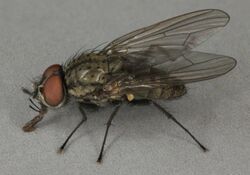Biology:Delia platura
From HandWiki
Short description: Species of fly
| Delia platura | |
|---|---|

| |
| Delia platura at Nebo, North Wales (July 2012) | |
| Scientific classification | |
| Domain: | Eukaryota |
| Kingdom: | Animalia |
| Phylum: | Arthropoda |
| Class: | Insecta |
| Order: | Diptera |
| Family: | Anthomyiidae |
| Genus: | Delia |
| Species: | D. platura
|
| Binomial name | |
| Delia platura (Meigen, 1826)
| |
| Synonyms[1] | |
| |
Delia platura, the seedcorn maggot or the bean seed fly, is a fly species in the family Anthomyiidae.[2]
D. platura is an agricultural pest of peas and beans. It is a vector of bacteria that cause potato blackleg.[3][4] It can be controlled by mouldboard ploughing.
See also
- Agriculture in the United Kingdom
References
- ↑ Chandler, Peter J. (1998). Checklists of Insects of the British Isles (New Series) Part 1: Diptera. Handbooks for the Identification of British Insects. 12. Royal Entomological Society. pp. 1–234.
- ↑ Delia platura at inra.fr (English)
- ↑ Gallegly, M E; Barnett, H L (1989). "Julian Gilbert Leach: Pioneer Leader in Plant Pathology". Annual Review of Phytopathology (Annual Reviews) 27 (1): 35–41. doi:10.1146/annurev.py.27.090189.000343. ISSN 0066-4286. "Dr. Leach first became impressed with the role of insects in the development of plant diseases, and the potential for research in this field, when he began a study in 1923 of the role of the seed-corn maggot in the development of potato blackleg. This classic study, published in 1926 (5), illustrates how insects break down natural defense barriers, such as the wound periderm, while transmitting inoculum of the pathogen to the infection court. Further studies revealed the symbiotic relationship of the causal bacterium and the maggot (7).".
- ↑ Rossmann, Simeon; Dees, Merete Wiken; Perminow, Juliana; Meadow, Richard; Brurberg, May Bente (15 June 2018). "Soft Rot Enterobacteriaceae Are Carried by a Large Range of Insect Species in Potato Fields". Applied and Environmental Microbiology 84 (12): e00281-18. doi:10.1128/AEM.00281-18. PMID 29625979. Bibcode: 2018ApEnM..84E.281R.
External links
Wikidata ☰ Q13584748 entry
 |

